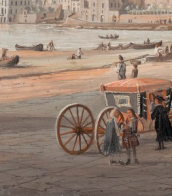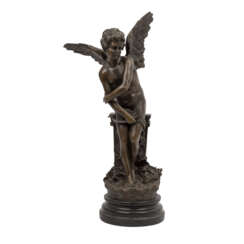hip moreau

Hippolyte Francois Moreau was a French sculptor renowned for his exquisite bronze and marble sculptures, particularly those depicting young women. Born into an esteemed family of sculptors in Dijon, France, Moreau honed his craft under the guidance of his father, Jean-Baptiste Moreau, and furthered his studies at the prestigious École des Beaux-Arts under François Jouffroy.
Hippolyte Francois Moreau's sculptures are celebrated for their delicate representation of youthful elegance and grace. His works like "Hébé," representing the goddess of youth, exemplify his ability to capture the softness and vitality of his subjects in stone and metal. The finesse in his sculptures earned him recognition and accolades, including medals at the Exposition Universelle in Paris in both 1878 and 1900.
Collectors and art enthusiasts continue to admire and acquire Hippolyte Francois Moreau's sculptures at auctions, with pieces ranging from intricate bronze statuettes to grand marble figures. His art not only reflects the artistic mastery of the 19th century but also continues to resonate with audiences today, showcasing the timeless appeal of his sculptures.
For collectors and experts in art and antiques, Hippolyte Francois Moreau's works offer a glimpse into the elegance of 19th-century French sculpture. Whether you're captivated by his bronze figures or mesmerized by his marble creations, staying updated on Moreau's pieces can enrich your collection and knowledge. Sign up for updates to receive the latest on sales, auctions, and exhibitions featuring Hippolyte Francois Moreau's timeless sculptures.


Hippolyte Francois Moreau was a French sculptor renowned for his exquisite bronze and marble sculptures, particularly those depicting young women. Born into an esteemed family of sculptors in Dijon, France, Moreau honed his craft under the guidance of his father, Jean-Baptiste Moreau, and furthered his studies at the prestigious École des Beaux-Arts under François Jouffroy.
Hippolyte Francois Moreau's sculptures are celebrated for their delicate representation of youthful elegance and grace. His works like "Hébé," representing the goddess of youth, exemplify his ability to capture the softness and vitality of his subjects in stone and metal. The finesse in his sculptures earned him recognition and accolades, including medals at the Exposition Universelle in Paris in both 1878 and 1900.
Collectors and art enthusiasts continue to admire and acquire Hippolyte Francois Moreau's sculptures at auctions, with pieces ranging from intricate bronze statuettes to grand marble figures. His art not only reflects the artistic mastery of the 19th century but also continues to resonate with audiences today, showcasing the timeless appeal of his sculptures.
For collectors and experts in art and antiques, Hippolyte Francois Moreau's works offer a glimpse into the elegance of 19th-century French sculpture. Whether you're captivated by his bronze figures or mesmerized by his marble creations, staying updated on Moreau's pieces can enrich your collection and knowledge. Sign up for updates to receive the latest on sales, auctions, and exhibitions featuring Hippolyte Francois Moreau's timeless sculptures.



Hippolyte Francois Moreau was a French sculptor renowned for his exquisite bronze and marble sculptures, particularly those depicting young women. Born into an esteemed family of sculptors in Dijon, France, Moreau honed his craft under the guidance of his father, Jean-Baptiste Moreau, and furthered his studies at the prestigious École des Beaux-Arts under François Jouffroy.
Hippolyte Francois Moreau's sculptures are celebrated for their delicate representation of youthful elegance and grace. His works like "Hébé," representing the goddess of youth, exemplify his ability to capture the softness and vitality of his subjects in stone and metal. The finesse in his sculptures earned him recognition and accolades, including medals at the Exposition Universelle in Paris in both 1878 and 1900.
Collectors and art enthusiasts continue to admire and acquire Hippolyte Francois Moreau's sculptures at auctions, with pieces ranging from intricate bronze statuettes to grand marble figures. His art not only reflects the artistic mastery of the 19th century but also continues to resonate with audiences today, showcasing the timeless appeal of his sculptures.
For collectors and experts in art and antiques, Hippolyte Francois Moreau's works offer a glimpse into the elegance of 19th-century French sculpture. Whether you're captivated by his bronze figures or mesmerized by his marble creations, staying updated on Moreau's pieces can enrich your collection and knowledge. Sign up for updates to receive the latest on sales, auctions, and exhibitions featuring Hippolyte Francois Moreau's timeless sculptures.


Gustave Moreau was a French artist and an important figure in the Symbolist movement. Jean Cassou called him "the Symbolist painter par excellence". He was an influential forerunner of symbolism in the visual arts in the 1860s, and at the height of the symbolist movement in the 1890s, he was among the most significant painters.


Hippolyte Francois Moreau was a French sculptor renowned for his exquisite bronze and marble sculptures, particularly those depicting young women. Born into an esteemed family of sculptors in Dijon, France, Moreau honed his craft under the guidance of his father, Jean-Baptiste Moreau, and furthered his studies at the prestigious École des Beaux-Arts under François Jouffroy.
Hippolyte Francois Moreau's sculptures are celebrated for their delicate representation of youthful elegance and grace. His works like "Hébé," representing the goddess of youth, exemplify his ability to capture the softness and vitality of his subjects in stone and metal. The finesse in his sculptures earned him recognition and accolades, including medals at the Exposition Universelle in Paris in both 1878 and 1900.
Collectors and art enthusiasts continue to admire and acquire Hippolyte Francois Moreau's sculptures at auctions, with pieces ranging from intricate bronze statuettes to grand marble figures. His art not only reflects the artistic mastery of the 19th century but also continues to resonate with audiences today, showcasing the timeless appeal of his sculptures.
For collectors and experts in art and antiques, Hippolyte Francois Moreau's works offer a glimpse into the elegance of 19th-century French sculpture. Whether you're captivated by his bronze figures or mesmerized by his marble creations, staying updated on Moreau's pieces can enrich your collection and knowledge. Sign up for updates to receive the latest on sales, auctions, and exhibitions featuring Hippolyte Francois Moreau's timeless sculptures.


Mathurin Moreau was a distinguished French sculptor, celebrated for his contributions to the academic style of the 19th century. Born into an artistically eminent family in Dijon, France, on 18 November 1822, Moreau honed his craft under the guidance of his father before enrolling at the prestigious École des Beaux-Arts. He emerged on the artistic scene with his first exhibition at the Salon of 1848, and his mastery of sculpture earned him a medal of honor from the Salon in 1897.
Moreau's legacy is enshrined in the beauty of his statuary art. His works, especially the cast iron fountains with patina bronze, are admired in public squares across major cities globally. These pieces exemplify the blend of technical skill and aesthetic vision that defines Moreau's style. His artistry continues to captivate collectors and art aficionados, with his pieces fetching considerable attention at auctions and exhibitions.
As an artist who significantly shaped the visual landscape of his time, Mathurin Moreau's creations are a testament to the enduring allure of classical sculpture. For those with a passion for 19th-century art, Moreau's works offer a timeless elegance that complements any collection. If you wish to delve into the world of M. Moreau's sculptural masterpieces, sign up for our exclusive updates and unearth the magnificence of this sculptural maestro's works.


Gustave Moreau was a French artist and an important figure in the Symbolist movement. Jean Cassou called him "the Symbolist painter par excellence". He was an influential forerunner of symbolism in the visual arts in the 1860s, and at the height of the symbolist movement in the 1890s, he was among the most significant painters.


Édouard Manet, a French modernist painter born in 1832, was one of the pioneering artists of the 19th century who ventured into painting modern life, marking a significant transition from Realism to Impressionism. His notable works, such as "The Luncheon on the Grass" and "Olympia," both created in the early 1860s, were radical for their time and sparked controversy for their unconventional subject matter and depiction of modern life. These pieces, among others, have been recognized as milestones in the development of modern art.
Manet's background was one of privilege and connection, coming from an upper-class family with strong political ties. Despite expectations for him to pursue a career in law or the navy, Manet was drawn to painting from a young age, influenced by his uncle and the works of Old Masters like Diego Velázquez and Francisco José de Goya during his visits to the Louvre. His early rejection from the naval academy led him to fully commit to an art education under Thomas Couture, where he developed his unique style characterized by loose brush strokes and a focus on contemporary subjects over traditional historical, religious, or mythological themes.
Throughout his career, Manet's work was often met with criticism for its apparent disregard for traditional painting techniques and its bold choice of subject matter. Despite this, his exhibitions, including a self-organized one across from the Exposition Universelle in 1867, gradually gained the recognition and support of fellow artists and critics. His relationships with contemporaries like Émile Zola, Edgar Degas, and Claude Monet were crucial in his development and in establishing his legacy as a forerunner to the Impressionist movement, despite never formally joining their exhibitions.
Manet's influence on modern art cannot be overstated. His works are housed in prestigious museums worldwide, including the Musée d'Orsay in Paris, which holds "The Luncheon on the Grass," a testament to his enduring impact on the art world. Manet's ability to capture the essence of modern life, combined with his innovative techniques, positioned him as a central figure in the transition towards modern artistic expressions.
For collectors and experts in art and antiques, Manet's work represents not just the innovation of the 19th century but also the enduring appeal of an artist who dared to challenge the status quo. His paintings are not just artifacts of their time but also serve as a bridge between traditional and modern art, offering insight into the evolution of artistic expression.
To stay informed about new product sales, auction events, and updates related to Édouard Manet, signing up for updates can be a valuable resource for enthusiasts looking to deepen their understanding of this pivotal artist's contributions to the world of art.















































































